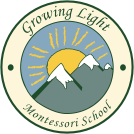 Yoga
Yoga
Tara Stafford, teacher of the Growing Light Montessori afternoon program, is our resident Yogi. Tara received her yoga training at about the same time she took her Montessori Teacher training. It was a natural progression to start bringing yoga into the classroom.
Children love to move! It is this movement that allows them to release some energy in preparation for what we call “Making Silence”. This silence is the true benefit of yoga. In today’s busy world, our children rarely have the opportunity to just be. When children learn techniques for self-health, relaxation, and inner fulfillment, they can navigate life’s challenges with a little more ease. Yoga at an early age encourages self-esteem and body awareness with a physical activity that’s noncompetitive. Fostering cooperation and compassion—instead of opposition—is a great gift to give our children.
Art
At Growing Light Montessori School, inspiration for artistic creative expression is all around us!
Art materials such as glue, scissors, and markers are kept on low shelves and are always available to the children. The use and care of these materials are introduced through group lessons early in the year. We teachers then monitor and encourage mastery of the skills taught as the children use their imaginations to create their unique pieces of art.
Artistic expression also enhances and extends the science and social studies curriculums offered at our school. For example, we practice the skill of weaving when we are learning about Native Americans. The children make fish prints when we study fish. We do leaf rubbings when we observe the changing of the seasons. Art in the Montessori classroom encourages hands-on learning and creative expression vital to its basic philosophy of “follow the child”.
 Science
Science
The Science area of our classroom is designed to encourage the children to use the scientific method of inquiry as they learn about their world. It is at circle time that the children begin to explore the wonder of our beautiful planet.
In the beginning of the school year, we study our solar system. Because children have such vivid imaginations, they can begin to understand such a vast subject. We discuss how our earth got its shape and how the basic landforms were created. We study extensively the characteristics of a living thing and the evolution of life. This includes learning about animal kingdoms, beginning with microorganisms and concluding, at the end of the year, with the study of mammals.
These are just two of the areas of study in our extensive science curriculum.
 School Garden
School Garden
Gardening is a wonderful way for children to connect with nature and nurture living things. It provides learning opportunities when studying parts of seeds, flowers, and plants. Children love to dig in the dirt and get great exercise while doing so.
We are fortunate to have classroom gardens where our children can be part of the growing process. They have ownership of the gardens as well as the food and flowers produced in them. We have had the beautiful opportunity of planting seeds and watching them sprout inside. We transfer them into our garden when weather allows.
Our Summer Camps enjoy most of our garden’s bounty, but some Fall crops are still producing for back to school. We enjoy tasting, cooking with, and even doing art with the colorful things we grow!

 Yoga
Yoga
 Science
Science School Garden
School Garden